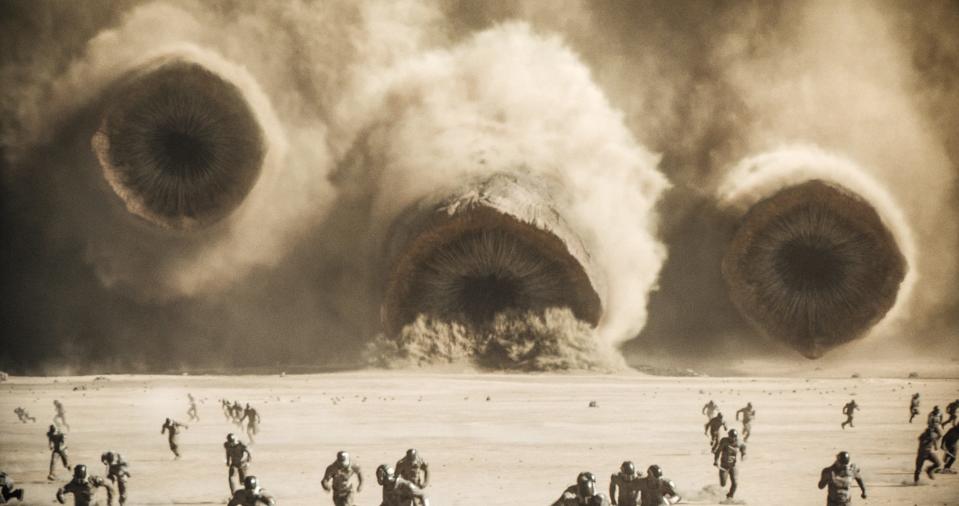-
The desert planet Arrakis in “Dune: Part Two” has extreme temperatures and little water.
-
To survive on such a planet, technology and adaptability are needed.
-
Three experts explain what it might be like to live on the planet of Dune.
In a distant galaxy, 20,000 years in the future, a scorching planet with arid deserts and little water is home to semi-nomadic, blue-eyed inhabitants, the Fremen.
Frank Herbert first described this harsh, fictional world of Arrakis in his 1965 novel ‘Dune’, which was recently adapted into a film trilogy. The second installment of the trilogy, “Dune: Part Two,” debuted in U.S. theaters on Friday.
The film was shot in the deserts outside Abu Dhabi, but we wondered what it would actually take to survive in a real Arrakis.
While it would take some ingenuity and technology, it wouldn’t be impossible, according to the scientists we spoke to.
“There are populations that have lived in deserts for centuries and even millennia,” Seth Collings Hawkins, a wilderness medicine specialist at Wake Forest University School of Medicine, told Business Insider.
What planet Dune would look like in real life
“There are so many factors that make Earth habitable for humans,” Amy J. Kreykes, an expert in aerospace medicine at the University of Texas Medical Branch, told BI.
That includes everything from the atmosphere to the distance from the sun to the available water.
“Everything is just uniquely perfect,” she said, “and any deviation from that could make other environments hostile to humans.”
Dune’s planet Arrakis has huge sandworms, a medicine known as a spice that aids in interstellar travel, and two moons. Yet it is not completely different from Earth.


When “Dune: Part One” was released in 2021, meteorologist Alexander Farnsworth of the University of Bristol and several other scientists used a weather forecast climate model to simulate the conditions of Arrakis.
They entered everything they could find into The Dune Encyclopedia about the planet’s geographic features, atmosphere, and astronomy.
There were a few places where the team’s model differed from the book’s descriptions, such as the weather at the planet’s poles and the tropics.
But overall, Farnsworth said he was impressed with the world Herbert created.
“I think what surprised me most overall was how accurate Frank Herbert was in imagining a desert world without a physics background or a supercomputer to do any kind of calculations on,” he said.
“He must have done a tremendous amount of research into the different components of the Earth system to understand how such a world might work,” he added. In fact, Herbert said he spent six years researching the book.
Based on their calculations, Farnsworth and the other researchers found that life on Arrakis would be possible, but probably not as pleasant.
Surviving the lack of water


Planet Arrakis has no oceans, lakes or even small puddles on its surface. Needless to say, this is bad news for humans.
“There’s a rule of threes,” Hawkins said. The human body can survive without oxygen for about three minutes, without water for about three days, and without food for about three weeks. “This would be the point where your body would start to break down,” he said.
To survive such dry conditions on Dune, the fictional Fremen wear so-called stillsuits, which collect body perspiration and other bodily fluids and turn them into drinkable water.
However, this concept is not completely sci-fi.
Hawkins called the space the “ultimate low-water environment.” That’s why the International Space Station’s toilets convert almost 85% of astronauts’ urine into drinking water.
Recovering that moisture is essential in environments where no external source is available. But as crucial as water is, on Arrakis the real killer is the temperature.
“You’d probably get heat stroke before you died of dehydration,” Hawkins said.
Survive the extreme temperatures


Unlike the book, Farnsworth’s scientific model of a real Arrakis found that the tropics were more hospitable than the polar regions because temperatures would be milder all year round.
At the poles, temperatures ranged from 158 degrees Fahrenheit in summer to -76 degrees Fahrenheit in winter. Meanwhile, temperatures in the tropics are expected to range from 56 to 113 degrees.
“So [at the poles] it is not only heat stress, but also cold stress that living things face,” he said of a real Arrakis.
Therefore, if you could choose, you would want to live close to the equator on Arrakis.
“The most feared consequence of being outside in that environment is heat stroke, which literally cooks the brain,” Hawkins said. The body temperature would rise to 106 or 107 degrees Fahrenheit, hotter than a fever.


“During the day you just wouldn’t travel at all,” he said. Everyone would find shelter until the temperature started to cool at night. If you have to go out during the day, you need something similar to a still suit.
‘It really seems paradoxical [to cover yourself]”But we now know that a big part of the problem is radiation and heat exposure from the sun,” Hawkins said.
Certain fabrics are both breathable and good at reflecting heat. Incorporating thermally conductive materials into clothing can help, but you would still want some sort of internal fan or air conditioning, Hawkins said.
“With technology, we can actually add tools that help extend our time in the sun or in warm environments with fewer bad consequences,” Hawkins said.
Surviving the atmosphere


When it comes to the composition of the atmosphere, “people are very specific in their needs,” Kreykes said.
The atmosphere on Arrakis is similar to that of Earth. It has a similar pressure, slightly less nitrogen (74.32% compared to about 78% on our planet) and slightly more oxygen (23.58% versus 21% on Earth).
Despite the similarities, people can still have an adjustment period.
“Any time you start messing with the atmosphere and changing those parameters, it can have significant consequences for humans,” Kreykes said. “Any deviation would have to be looked at very, very carefully for its habitability for humans.”
Arrakis also has slightly less carbon dioxide than Earth, which could affect plant growth. It would be a new challenge, on top of the limited water sources.
A glimpse of the future Earth?


While learning to tame giant sandworms is a problem that Earth will hopefully never have to deal with, parts of our planet aren’t all that different from those in Arrakis.
For example, the Sonoran Desert along the Mexican-American border recently reached 177 degrees Fahrenheit, one of the hottest surface temperatures ever recorded.
Arizona, New Mexico and California have all experienced droughts and water shortages in recent years.
As the Earth continues to warm due to climate change, excessive heat and water scarcity will continue to affect not only people, but also plants and animals worldwide.
One of the reasons for the popularity of “Dune” and similar speculative fiction, Hawkins said, is that we can see elements of our own future in them, “and I think this story has that message for us.”
Read the original article on Business Insider